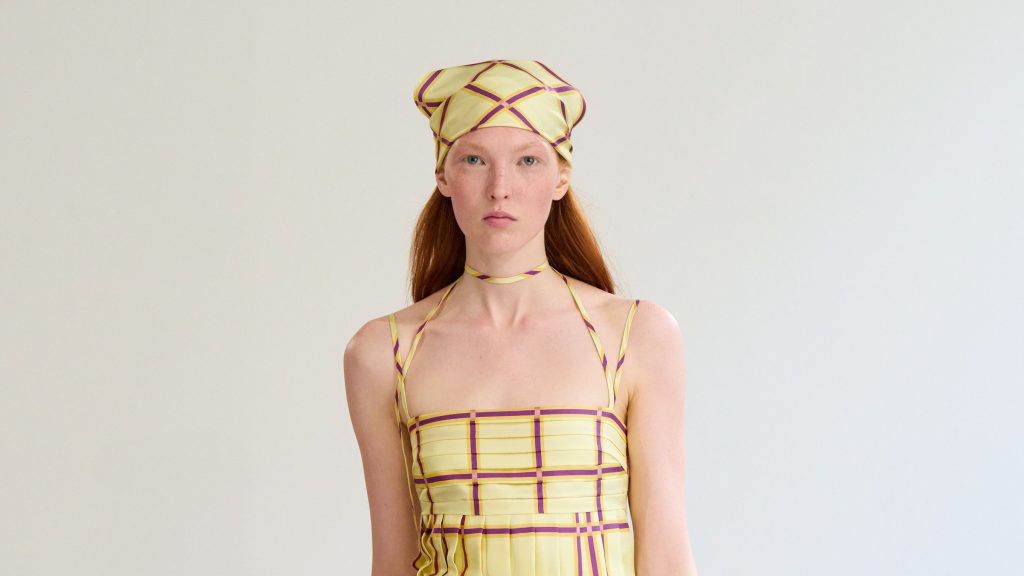This afternoon, a pack of buyers and editors could be spotted crowding their way into Emilia Wickstead’s flagship store on Sloane Street—not for a spot of mid-fashion week shopping, it turned out, but to take in the designer’s new collection. Wickstead and her team had transformed the space into a salon-style setup, with rows of elegant wooden chairs lining each interconnecting room. To those familiar with the early days of Wickstead’s career, when she acquired a following by hosting trunk shows at her first store on Pont Street, it felt like a full-circle moment. “I actually designed the Sloane Street store to be a show space,” she said at a preview. “I think it feels right for where we are as a brand. It feels really nice to invite everyone into the house that we’ve built.”
Wickstead also said she designed the space—all glass and marble and sharp angles—to recall a contemporary art gallery, which made it an appropriate backdrop for a collection that took its cues from the work of Robert Mapplethorpe. Given the provocative, eye-popping material found in some of Mapplethorpe’s more memorable work, it may sound like an unexpected pairing for a designer whose elegant dresses are beloved by the royals and Oscar-winning leading ladies. But Wickstead was quick to point out that the parallels are more extensive than you might think. “Obviously he’s known for his radical sensuality and his explorations of identity, but equally for his beautiful portraits of women, and portraits of the shapes of the body, and using flowers as a metaphor for the body,” she said. “I find his work to be very emotional and romantic and poetic and sometimes sad. And punchy, of course.”
Wickstead cleverly translated this sentiment into clothes that could easily slot into her customer’s wardrobe: first out were a series of plaid dresses that were sliced and layered and twisted around the waist to create jarring clashes of diagonals, which eased into a series of more structured dresses with relaxed and often pleated skirts that carried a satisfying swish as models walked at a ferocious pace across the checkered floors. That “punch” factor came through in a striking drop waist gown slathered with bright yellow sequins and a royal blue bubble dress, as well as a handful of tomboyish looks—shirts or polo knits with jeans, miniskirts with grid-like criss-crossing strips of fabric—that showcased Wickstead’s sharp eye for (and growing business around) more casual separates.
There were direct references to the moody palettes Mapplethorpe favored in some of his lesser-known color photographs of flowers—icy blue, powder pink, buttercup yellow—as well as black lace-up leather shoes and ties decorated with a print of vibrant orchids floating in a black ether. (A nod to Mapplethorpe’s kinkier side was rendered in a very Wickstead way, through strips of fabric that were tied around garments or whizzed up into bows, replacing the leather straps and belts Mapplethorpe was so fond of with delicate silks.) The haunting soundtrack, meanwhile, sampled the “Vissi d’arte” aria from Tosca, which Patti Smith wrote about listening to on repeat following Mapplethorpe’s death. Wickstead cited Smith, too, as someone she was thinking about while designing the collection; specifically in the ease and effortlessness of her style, which Wickstead translated into pieces cut from chiffons and exquisitely crinkled satins, as well as a general emphasis on loose, breezy silhouettes.
It says a lot about Wickstead as a designer that, while she could easily rest on her laurels, continuing to pump out pretty dresses and tailoring for her loyal clientele of largely professional and creative women, she still likes to challenge herself. The reason her clientele is so loyal, after all, is because she instinctively understands them. (Because, well, Wickstead is a creative professional herself.) And just like Wickstead, who continues to push into new territory and find fascinating ways to fold her wide-ranging cultural interests into her collections, she understands they want to be challenged as well. “I think that all of Mapplethorpe’s portraits were always very commanding, and I do think that the Emilia Wickstead woman is quite commanding,” the designer said. “I didn’t want the collection to feel tame, but I wanted to find the right balance. The inspiration was very strong, but I also wanted to make it my own.” That she did. And to paraphrase another figure in Mapplethorpe’s orbit, it was a delight to see Wickstead walk on the wild side.

